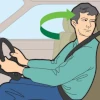RESEARCH - Safety Evaluation of Pedestrian Countdown Signals
 Here's a document from the US Federal Highway Authority that looks at the safety benefit of pedestrian countdown signals. The study results showed that after the implementation of these signals, pedestrian crashes decreased by 9 percent, total crashes decreased by 8 percent and rear-end crashes decreased by 12 percent.
Here's a document from the US Federal Highway Authority that looks at the safety benefit of pedestrian countdown signals. The study results showed that after the implementation of these signals, pedestrian crashes decreased by 9 percent, total crashes decreased by 8 percent and rear-end crashes decreased by 12 percent.

 On November 7, 2018 Cst. Neid was participating in a two person enforcement operation where he was the observer beside Highway 33 in Kelowna. In his evidence he states that he observed Corinne Jackson driving toward him "shovelling" food from a bowl into her mouth and was not holding the steering wheel.
On November 7, 2018 Cst. Neid was participating in a two person enforcement operation where he was the observer beside Highway 33 in Kelowna. In his evidence he states that he observed Corinne Jackson driving toward him "shovelling" food from a bowl into her mouth and was not holding the steering wheel. Is it really necessary to make a shoulder check while driving? If you expect to pass a driving exam in British Columbia the answer is a definite yes. However, some driving schools are teaching mirror adjustment techniques to replace shoulder checks.
Is it really necessary to make a shoulder check while driving? If you expect to pass a driving exam in British Columbia the answer is a definite yes. However, some driving schools are teaching mirror adjustment techniques to replace shoulder checks.
 We all know that the law requires that we wear our seat belts when driving. The Motor Vehicle Act says in part "..wear the complete seat belt assembly in a
We all know that the law requires that we wear our seat belts when driving. The Motor Vehicle Act says in part "..wear the complete seat belt assembly in a  I've been driving with
I've been driving with  The addition of a five-foot stop sign arm installed on one of Mineral County, West Virginia's school buses is proving to be helping to keep children safer, school officials said. John Droppleman of the school system’s transportation department told the Board of Education on Tuesday that the extended arm was installed on bus No. 57.
The addition of a five-foot stop sign arm installed on one of Mineral County, West Virginia's school buses is proving to be helping to keep children safer, school officials said. John Droppleman of the school system’s transportation department told the Board of Education on Tuesday that the extended arm was installed on bus No. 57. We take the lines painted on our roads for granted today, but the first attempts at implementing them were met with resistance. This short video on the history of lane markings is a study in the rapid effect of new technologies and the ability of a few people with a good idea to have a large impact.
We take the lines painted on our roads for granted today, but the first attempts at implementing them were met with resistance. This short video on the history of lane markings is a study in the rapid effect of new technologies and the ability of a few people with a good idea to have a large impact. School crosswalk safety should be a high priority for parents who drive to drop off and pick up their children each day. They are supposed to be the responsible ones who provide the good example in what is often a confusion of traffic.
School crosswalk safety should be a high priority for parents who drive to drop off and pick up their children each day. They are supposed to be the responsible ones who provide the good example in what is often a confusion of traffic.
 Holland has a serious pollution problem from nitrogen oxides and particulate matter in the air. The air pollution levels are above those permitted by European law and are mainly caused by motor vehicle traffic and factories.
Holland has a serious pollution problem from nitrogen oxides and particulate matter in the air. The air pollution levels are above those permitted by European law and are mainly caused by motor vehicle traffic and factories.